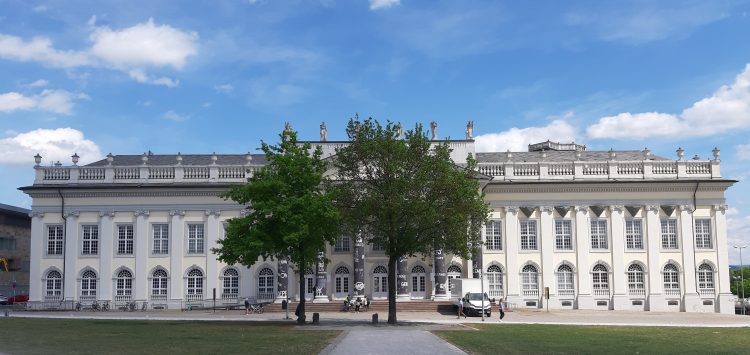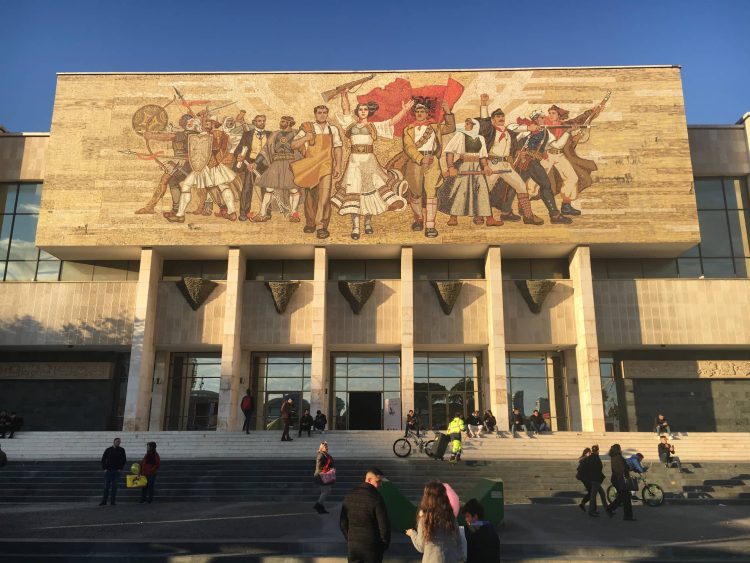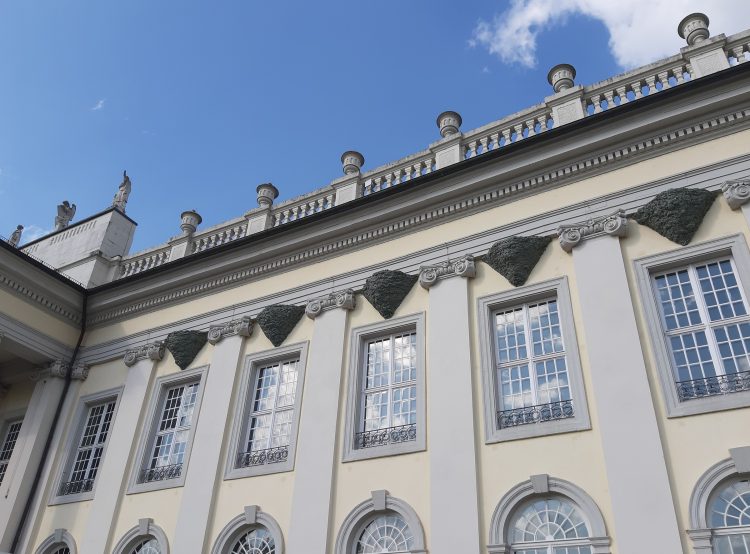How Many Swallows Make a Summer? On Sead Kazanxhiu’s Nests

Sead Kazanxhiu: The Nests on the façade of the Museum Fridericianum in Kassel, documenta fifteen, 2022. Photo courtesy of the artist.
Sead Kazanxhiu is one of the most engaged protagonists of the contemporary Albanian art scene. His artworks are dedicated to the culture, problems and the status of the Roma community from which he originates. Sead’s activist and artistic practice are in symbiosis with the broader struggle for the awareness of the significance of Romani culture, as well as against systemic violence and anti-Roma stereotypes. This involves working on the education of majority populations in order to resist racist, classist and anti-Romani prejudices that are still being perpetuated within the European societies of today. Having this in mind, the focus here is on the following questions: in what ways does this kind of artistic practice contribute to the epistemological changes in institutions; and what are the possibilities of decolonising museums and large-scale exhibitions?
The documenta fifteen curatorial concept focuses on the notion of lumbung,[1] which means warehouse for collectively produced resources in accordance with the logic of communal sharing. The aim is to amend the injustices that are embedded in capitalism, colonialism and patriarchy. From this perspective, it is consistent with the intentions of ERIAC and OFF-Biennale Budapest to bring their contemporary art project, RomaMoMA,[2] and to present within this framework several leading artists of Romani descent, including Sead Kazanxhiu. All the works of these artists are grounded in their communities, and their project “presents the untold past and the unfolding present through artworks and storytelling”.[3] Thus, at this prestigious international exhibition, it is the first time that Romani artists have been given a space to exhibit their works and to problematise the principles of documenta as an institution dedicated to exhibiting contemporary art.[4] One of the most striking groupings of artworks on display in the museum is certainly Ceija Stojka’s paintings and drawings that depict the plight and suffering of Romani people during the Samudaripen.
As a part of the documenta fifteen exhibition, Sead placed oversized swallow nests on the classical façade of the Museum Fridericianum in Kassel. The visitors are confronted with a surprising intervention that conveys the artist’s message in a skilful manner, bringing into question the exhibition policy of that institution. As the artist has said, “The nests are used as metaphors to talk about issues, concepts and cultures that are not part of our public institutions and history, even though we are aware in our consciousness of their existence. In this context, nests are used to create a new reality, in which they take on another function. In this new function, the nests serve as a means to create a physical space for the cultures that are not institutionalised and are not part of public institutions; and at the same time, to influence the need for interaction between people, and with the environment that surrounds us”.[5] Thus, Sead’s intervention articulates a concrete problematisation of public institutions that leads to a deeper understanding of epistemic justice by referring to spaces of solidarity and collectiveness.
Romani Institutional Critique
Sead created an earlier version of the Nests in 2018 on the façade of the National History Museum in Tirana. The Museum is located on the city’s central square, and its function, from the communist era up until today, is to provide a coherent survey of the history of the Albanian people, from the standpoint of national discourse and the nation-building narrative. According to that discourse, the nation represents a monolithic bloc, in which the Roma people are obliged to dissolve themselves by rejecting their own identity.[6] The museum was built during the communist era, and the heroic socialist-realist mosaic on the main façade of the building offers a reading of the nation’s ideology during Enver Hoxha’s regime. The function of the Nests was clear: it was meant to voice the autonomy of Romani culture outside the museum, and proclaimed a demand for Romani culture to be accepted and housed there. In making such a gesture, Sead wanted to correct the epistemic injustice done to the Romani community as regards representation of the national history of Albania and the history of that barely visible minority. Furthermore, it represented an appeal to correct that wrongdoing in a concrete manner by improving the living conditions of the Romani community in Albania.

Sead Kazanxhiu: The Nests, National History Museum, Tirana (Albania), 2018. Photo courtesy of the artist.
Sead was born two years after Enver Hoxha passed away, and he grew up during the transitional chaos of the 1990s in Albania. He studied at the University of Arts in Tirana during the 2000s, a period of neoliberal capitalist transformation of the Albanian society, which remained on the economic periphery of Europe. It is a society in which he is a member of a minority that endured a very tough life. Belonging to the younger generation of artists, Sead feels no personal relationship with the previous epoch, nor does he wish to relate his artworks to the history of dictatorship in a manner expected of the artists coming from the post-communist contexts of Eastern Europe and the Balkans. The tradition of conceptual and dissident artistic practices that bring about a critical relation vis-à-vis art institutions, as well as state institutions in general (which in Eastern Europe have a different social status than in the West)[7] does not represent the artist’s primary interest.
In contrast to those practices, Sead is coming to grips with the issues of racialization and the status of the Romani minority that is colonised by the majority populations in all of the Balkan countries. He establishes an extraordinarily sensitive relationship towards national institutions and the institution of art in general, which he problematises from the position of Romani institutional critique, i.e., through articulating a proposal for its decolonisation. The Nests were placed on the façade of the National Museum in order to provide a sense of warmth and hospitality and to welcome Roma culture inside, and to enable a change in stereotypes, perception and relation of the majority towards the other – the other that still lacks an adequate place within the framework of the persistent national narratives.
Hirundi[8] ante portas
The context of Sead’s intervention in Kassel differs from that in Tirana, and the status of the museum on whose façade he intervenes is more complicated. It is a well-known fact that the Fridericianum is an institution of extraordinary historical and cultural significance in Germany. It was built by Frederick II, Landgrave of Hesse-Kassel (known for making income from renting his soldiers to the British Empire for colonial wars), and it was opened in 1779 as one of the first public buildings in Germany explicitly dedicated to becoming a museum.[9] It was later used as a library, and it was bombed by the Allies during the Second World War. The Fridericianum is the central venue of the documenta, which is the most visited exhibition in Germany, and thus it guarantees great visibility for the intervention on its façade.
Sead Kazanxhiu has intervened with his Nests on the typical classical architecture that was designed in the spirit of rationalism by Frederick’s court architect, Simon Louis Du Ruy, but which also represents an outcome of historical military and colonial activities. Sead managed to incorporate on the façade five huge nests, skilfully built out of a wood and metal construction covered with a coloured polymer. The installed objects are painted so that they realistically mimic swallow nests with only one “fault” – their oversized dimensions. The Nests look so much like the real thing, that the birds themselves begin to visit them. Only a few days after the installation, birds began to use the artwork for their own purposes.

Sead Kazanxhiu: The Nest on the façade of the Museum Fridericianum in Kassel, documenta fifteen, 2022. Photo courtesy of the artist.
From the birds’ point of view, the use-value of the artistic installation represents something that cannot be denied as to its practical and primary usage. Moreover, there is a law in Germany protecting birds, and a part of it says that if birds start nesting, it is not recommendable to tear down those nests. Furthermore, there is a penalty prescribed by the law for destroying birds’ nests.[10] Due to this use-value of the artwork, this installation is brought into a very interesting relation to the legal and institutional order. There is a further question as to whom this artwork is meant for, and in what manner it functions within the legal, social and artistic/cultural order. Will the staff of the Fridericianum remove Sead’s installation after the exhibition concludes, despite the bird nest preservation law? Will the museum and the documenta organisers be penalised for the possible removal of the Nests? And finally, what would the swallows that want to keep visiting the Fridericianum nests following the closing of the exhibition have to say? What will remain of the hospitality of the institution when it leaves the protected bubble of the documenta?[11]
Swallows are migratory birds, and they usually return to the same nests that are their temporary homes for the season, while Roma people are portrayed as nomadic by historical stereotypes concerning their migratory identity. For this reason, Sead refers in his previous artworks to the notion of Romani land (Romani phuv), or, alternatively, to house-making as a concept, as well as the notions of property, acknowledging no borders, and other concepts that have a completely different connotation within the Romani community than within majority populations.[12]
Sead’s artwork can be interpreted as one that primarily addresses birds, and only secondarily to human visitors of the exhibition, which corresponds to a radical negation of the Anthropocene as the era of mass extinction of many animal species. Additionally, the artwork operates within the domain of decolonisation by successfully occupying the face of the classical façade’s redundant symmetry, thus posing the question of obtaining the privilege to intervene in it. It is worth mentioning that Sead’s artwork is not the only one placed on the façade of the Fridericianum – the artworks of Dan Perjovschi are situated on the pillars at the entrance.[13]
A Hospitality Outside and Inside
Sead Kazanxhiu is interested in the questions surrounding the topic of home. His previous artworks relate to the problem of Roma evictions in Albania, as well as to the question of their housing.[14] Some of those artworks were a part of the protests in Albania held in front of the Parliament building,[15] and in front of the office of Prime Minister Edi Rama. The Nests exhibited in Kassel enable us to understand, in addition to the previous protest contexts, the depth of the notions of home and hospitality. According to Sead’s personal interpretation,[16] the nests placed on the Fridericianum façade have the function of inducing pleasant feelings in visitors entering the venue. They serve the task of making the museum a hospitable place for the Romani art and culture that remained outside of it for such a long time; now they are finally admitted in, with the works of other Romani artists exhibited inside, like those of Ceija Stojka. The Nests placed on the outer wall also signify that Romani art and culture was external to the elite institutions of art, which is in part still the case today, while the nests themselves become signs of hope that this will bring the warmth of home to the Romani artworks within such institutions.

Sead Kazanxhiu: The Nest, documenta fifteen, Kassel, 2022, work in progress. Photo courtesy of the artist.
While at first glance, the Nests can be experienced in terms of a straightforward metaphor, they represent so much more, as they problematise the historic discrimination and the notion of hospitality that stands in an inseparable relation with the Romani artists. Placing the Museum into focus does not serve to deliver an abstract criticism that would quickly disappear in the vacuum of the aestheticisation of politics, as was so often the case. The intention here is to enable a process of decolonisation for the benefit of the community and, thus, all of us. Indeed, the Nests placed at the museum’s entrance supply us with a pair of glasses that enable us to see through the white and privileged order of things.
[1] documenta fifteen, one of the most significant contemporary art exhibitions internationally, is curated by ruangrupa, an Indonesian artist collective. It is the first curatorial collective coming from Asia to head this large international manifestation. See: https://documenta-fifteen.de
[2] RomaMoMA is a contemporary art project initiating a forum for collaborative reflection on a future Roma Museum of Contemporary Art, with the involvement of local and international, Roma and non-Roma artists, cultural experts, social scientists and the civil sphere. See: https://eriac.org/what-is-romamoma/
[3] One Day We Shall Celebrate Again: RomaMoMA at documenta fifteen presents the works of artists Daniel Baker, János Balázs, Robert Gabris, Sead Kazanxhiu, Damian Le Bas, Małgorzata Mirga-Tas, Omara (Mara Oláh), Tamás Péli, Selma Selman, and Ceija Stojka. It is curated by Daniel Baker, Ethel Brooks, Tímea Junghaus, Hajnalka Somogyi, Eszter Szakács, Katalin Székely, and Miguel Ángel Vargas.
See: https://offbiennale.hu/en/documenta-15/romamoma/
[4] At Manifesta 14 in Prishtina, Kosovo, Roma artists will be included as well. See: https://manifesta14.org/participant/romamoma-with-farija-mehmeti/
[5] Artist’s statement submitted to the curatorial teams of documenta and the OFF-Biennale Budapest.
[6] https://seadkazanxhiu.wixsite.com/visualart/the-nest
[7] In Eastern Europe during communism, art institutions were criticised for the lack of freedom, and certainly they did not exist in the sense of art market orientation as in the capitalist West. Spaces for performing the autonomy of artistic practice and liberal ideas were scarce. This specific social and historical context prompted art historians and theorists to employ the term institutional critique in a completely different manner than it was used in the West during the 1960s and 1970s when it was originally established. See: Alenka Gregorič and Suzana Milevska: “Inside Out: Critical Art Practices that Challenge the Art System and Its Institutions”, in: Inside Out — Critical Discourses Concerning Institutions, Alenka Gregorič and Suzana Milevska (eds.), Museum and Galleries of Ljubljana, City Art Gallery Ljubljana, Slovenia, 2017, pp. 8-24.
[8] Hirundi is swallow in Latin.
[9] Wolf von Both: “Friedrich II”, in: Neue Deutsche Biographie 5 (1961), pp. 508-309.
See: https://www.deutsche-biographie.de/pnd130249424.html
[10] https://www.bussgeldkatalog.org/schwalbennest-entfernen/
[11] In a country in which authorities have enforced deportation of Romani people that have been granted the Duldung, or so-called tolerated stay status. See: “A family fights deportation from Germany to North Macedonia”, Deutsche Welle, 2 April 2022.
https://www.dw.com/en/a-family-fights-deportation-from-germany-to-north-macedonia/a-61341708
[12] Sead made a series of artworks on these topics in the public space, and the description of some of them can be found here:
https://seadkazanxhiu.wixsite.com/visualart/i-dont-have-borders-to-protect
and https://seadkazanxhiu.wixsite.com/visualart/video
Further discussion of these artworks can be found in: Suzana Milevska: Rewriting the Protocols: Naming, Renaming, and Profiling. See:
https://www.romarchive.eu/de/visual-arts/subsection-rewriting-protocols/
[13] In contrast to the Nests, Dan’s drawings follow the form of the pillars, intervening in them with critical narratives in his typical manner. See: https://documenta-fifteen.de/en/lumbung-members-artists/dan-perjovschi/
[14] SHTEPIZEZA, or “Small House, Home Sweet Home” (2014), was a multimedia installation of 2500 small, individually crafted, plaster homes, with dimensions of 5 x 5 cm each. See: https://seadkazanxhiu.wixsite.com/visualart/dislocation-1
[15] His installation 8 for 8 of April was placed in front of the Albanian Parliament, as a symbolic protest, where he used his art to fight for the right of the Romani people to become a part of the decision-making system. See interview with Sead Kazanxhiu by Raino Isto:
https://afterart.org/2016/07/25/choices-to-be-made-an-interview-with-sead-kazanxhiu/
and https://seadkazanxhiu.wixsite.com/visualart/8-for-8th-of-april
[16] From my recorded conversation with the author on Zoom during the production of his artwork, 20 May 2022.
Text by Vladan Jeremić

[…] Previous Blog Entry […]
[…] Next Blog Entry […]